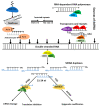Plant Non-Coding RNAs: Origin, Biogenesis, Mode of Action and Their Roles in Abiotic Stress
- PMID: 33182372
- PMCID: PMC7664903
- DOI: 10.3390/ijms21218401
Plant Non-Coding RNAs: Origin, Biogenesis, Mode of Action and Their Roles in Abiotic Stress
Abstract
As sessile species, plants have to deal with the rapidly changing environment. In response to these environmental conditions, plants employ a plethora of response mechanisms that provide broad phenotypic plasticity to allow the fine-tuning of the external cues related reactions. Molecular biology has been transformed by the major breakthroughs in high-throughput transcriptome sequencing and expression analysis using next-generation sequencing (NGS) technologies. These innovations have provided substantial progress in the identification of genomic regions as well as underlying basis influencing transcriptional and post-transcriptional regulation of abiotic stress response. Non-coding RNAs (ncRNAs), particularly microRNAs (miRNAs), short interfering RNAs (siRNAs), and long non-coding RNAs (lncRNAs), have emerged as essential regulators of plants abiotic stress response. However, shared traits in the biogenesis of ncRNAs and the coordinated cross-talk among ncRNAs mechanisms contribute to the complexity of these molecules and might play an essential part in regulating stress responses. Herein, we highlight the current knowledge of plant microRNAs, siRNAs, and lncRNAs, focusing on their origin, biogenesis, modes of action, and fundamental roles in plant response to abiotic stresses.
Keywords: abiotic stress; biogenesis; long non-coding RNA; non-coding RNA; transcriptional.
Conflict of interest statement
The authors declare that they have no competing interests.
Figures







Similar articles
-
Non-coding RNAs in the plant response to abiotic stress.Planta. 2012 Oct;236(4):943-58. doi: 10.1007/s00425-012-1693-z. Epub 2012 Jul 4. Planta. 2012. PMID: 22761008 Review.
-
Long non-coding RNAs: emerging players regulating plant abiotic stress response and adaptation.BMC Plant Biol. 2020 Oct 12;20(1):466. doi: 10.1186/s12870-020-02595-x. BMC Plant Biol. 2020. PMID: 33046001 Free PMC article. Review.
-
An insight into the roles of regulatory ncRNAs in plants: An abiotic stress and developmental perspective.Plant Physiol Biochem. 2023 Aug;201:107823. doi: 10.1016/j.plaphy.2023.107823. Epub 2023 Jun 7. Plant Physiol Biochem. 2023. PMID: 37327647 Review.
-
The roles of non-coding RNAs in male reproductive development and abiotic stress responses during this unique process in flowering plants.Plant Sci. 2024 Apr;341:111995. doi: 10.1016/j.plantsci.2024.111995. Epub 2024 Jan 23. Plant Sci. 2024. PMID: 38266717 Review.
-
Non-coding RNAs and Their Roles in Stress Response in Plants.Genomics Proteomics Bioinformatics. 2017 Oct;15(5):301-312. doi: 10.1016/j.gpb.2017.01.007. Epub 2017 Oct 7. Genomics Proteomics Bioinformatics. 2017. PMID: 29017967 Free PMC article. Review.
Cited by
-
Multi-omics revolution to promote plant breeding efficiency.Front Plant Sci. 2022 Dec 8;13:1062952. doi: 10.3389/fpls.2022.1062952. eCollection 2022. Front Plant Sci. 2022. PMID: 36570904 Free PMC article.
-
The Dynamism of Transposon Methylation for Plant Development and Stress Adaptation.Int J Mol Sci. 2021 Oct 21;22(21):11387. doi: 10.3390/ijms222111387. Int J Mol Sci. 2021. PMID: 34768817 Free PMC article. Review.
-
Ten new high-quality genome assemblies for diverse bioenergy sorghum genotypes.Front Plant Sci. 2023 Jan 4;13:1040909. doi: 10.3389/fpls.2022.1040909. eCollection 2022. Front Plant Sci. 2023. PMID: 36684744 Free PMC article.
-
milR20 negatively regulates the development of fruit bodies in Pleurotus cornucopiae.Front Microbiol. 2023 May 4;14:1177820. doi: 10.3389/fmicb.2023.1177820. eCollection 2023. Front Microbiol. 2023. PMID: 37213518 Free PMC article.
-
PmiR-Select® - a computational approach to plant pre-miRNA identification in genomes.Mol Genet Genomics. 2025 Jan 3;300(1):12. doi: 10.1007/s00438-024-02221-7. Mol Genet Genomics. 2025. PMID: 39751956
References
Publication types
MeSH terms
Substances
Grants and funding
LinkOut - more resources
Full Text Sources
Research Materials

